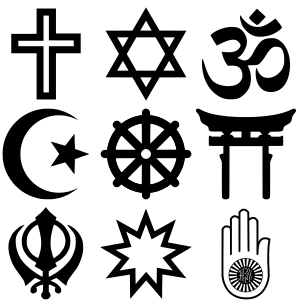Religious studies facts for kids
Religious studies is a way of learning about different religions and spiritual ideas. It's an academic subject, meaning it's studied in schools and universities. When people study religions, they look at beliefs, actions, and groups of people who follow a religion. They do this from a neutral, secular point of view, not trying to say one religion is better than another.
Some of the main religions you might learn about include Christianity, Buddhism, Islam, Sikhism, Judaism, and Hinduism. But religious studies also looks at many other spiritual paths and traditions from all over the world.
Contents
What is Religious Studies?
Religious studies is like being a detective for beliefs. You explore how people understand the world and their place in it. This includes looking at their stories, traditions, and how they live their lives. It's about understanding why people believe what they do.
It's different from learning a religion, like in a Sunday school. Instead, it's about learning about many religions. You learn about their history, their holy books, and their special ceremonies. You also learn about how religions affect society and culture.
Why Study Religions?
Studying religions helps you understand the world better. Religions have shaped history, art, and even how countries are run. By learning about different faiths, you can understand people from various backgrounds. This helps you become more open-minded and respectful.
It also helps you think critically about big questions. You might explore ideas about life, death, and what it means to be human. Religious studies teaches you to research, analyze, and form your own opinions. These are useful skills for any subject.
How Do People Study Religions?
Scholars who study religions use many different tools. They might read ancient texts or interview people about their beliefs. They also look at art, music, and buildings that are important to different faiths. It's a bit like being a historian, a sociologist, and an anthropologist all at once!
They try to understand religions from the inside out. This means learning about the experiences of people who practice a religion. They also compare different religions to find similarities and differences. This helps them see how diverse human beliefs can be.
Different Religions You Might Learn About
There are many religions and spiritual traditions around the world. Here are a few that are often studied:
- Christianity: This is the largest religion globally. It focuses on the teachings of Jesus Christ.
- Islam: Followers of Islam are called Muslims. They believe in one God, Allah, and follow the teachings of the Quran.
- Hinduism: This is one of the oldest religions. It has many gods and goddesses and a focus on karma and reincarnation.
- Buddhism: Based on the teachings of Siddhartha Gautama (the Buddha). It focuses on achieving enlightenment and peace.
- Judaism: An ancient monotheistic religion. It is the foundation for Christianity and Islam.
- Sikhism: A monotheistic religion from India. It emphasizes equality and service to others.
Religious studies also explores smaller, older, or indigenous traditions. These might include Shinto from Japan or the beliefs of various Indigenous peoples. Sometimes, scholars discuss if terms like "religion" fit all these different ways of life.
Religious Studies vs. Religious Education
Sometimes, people confuse "religious studies" with "religious education." They are related but different.
- Religious studies is an academic subject. It explores religions from a neutral, non-religious viewpoint. It's about understanding about religions.
- Religious education can sometimes mean teaching a specific religion to children. For example, learning about Christian beliefs in a church school. However, in many public schools, "religious education" is now more like "religious studies," teaching about many faiths.
The goal of religious studies is not to make you believe in a religion. Instead, it's to help you understand the world's rich tapestry of beliefs. It helps you become a more informed and thoughtful person.
Images for kids
-
Totem poles reflect the beliefs of the Indigenous peoples of the Pacific Northwest Coast.
See also
 In Spanish: Ciencias de la religión para niños
In Spanish: Ciencias de la religión para niños



